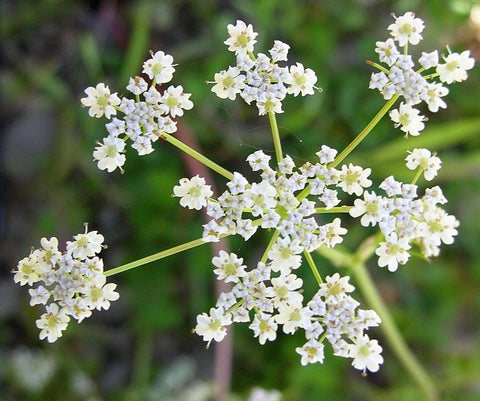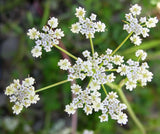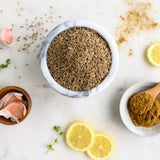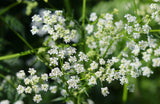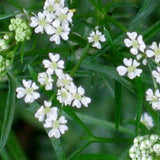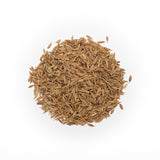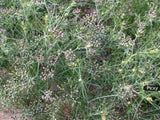Cumin (Cuminum cyminum L) is a leafy plant that grows low to the ground in China, India, the Middle East, and the Mediterranean region. The fruit of the plant is called the cumin seed, and it’s popular all over the world as a spice. Count: ~100
Our herb seeds are open-pollinated Heirloom, and non-GMO. Annual. The flavorful seeds are an important ingredient in many Mexican dishes; also used in bread and cakes. Small, tender, crawling plants reach about 6 inches tall. Fragrant, ferny foliage is similar to dill. Young leaves make a nice addition to salad mixes. Grows best in warmer climates, but will produce seeds in northern areas if started early8-12 hours of Sun Sprouts in 7-14 Days Ideal Temperature: 65-75 Degrees F Seed Depth: 1/4-1/2" Plant Spacing: 4-6" Frost Hardy: No Cuminum cyminum Days to maturity: 100 - 115 DaysSowing: Direct seed (recommended): Cumin requires a lengthy, warm growing season to ensure seed maturation. Sow seeds directly into prepared garden soil about 1/4- 1/2" deep when night temperatures stay above 50°F (10°C). Plants are somewhat fragile and have a tendency to "lodge" or fall over, especially after a hard rain or when plants are flowering. This should not harm seed development. To help avoid lodging, plant seeds close together in the row or bed so that the plants will support each other. Thin to 4-6" apart. Provide average to somewhat rich, well-drained soil.Growing Tips: Needs a long, hot summer (start early indoors in peat pots in shorter-season areas). Harvest the seeds when dry, before the seed-heads shatter. How to Grow CuminCumin is a flowering annual plant that grows to be about 12 to 20 inches tall. Its short-lived flowers are pink or white (flowering begins midsummer) and yield the cumin seeds used in cooking. Recommended for USDA Plant Hardiness Zones 5 to 10, cumin is a plant that takes about four months to reach maturity and prefers a hot growing season.This means if you live in an area with a short growing season, you'll need to start the seeds indoors, only transplanting them outdoors when temperatures (lows) will be at 60 degrees F or above and the plants are about 2 inches tall. For a general guide, start the seeds indoors about four to eight weeks before the final frost in your area.3Seeds should germinate in about seven to 14 days, and soaking them prior to planting (for about eight hours) may increase germination rates. Cumin seeds don't tolerate transplanting well, so it's best to use biodegradable pots that can be planted directly into the soil when the time comes.And because each cumin plant only produces a small number of seeds, you'll need to grow a lot of plants if you plan to use the seeds regularly. Cumin does best in full sun, so choose a bright, sunny spot in your garden and sow the seedlings about 4 inches apart, shallowly in the soil (about one-fourth inch deep), in rows that are 18 inches apart.You can also plant cumin in containers, and some suggest planting them in clumps rather than rows, which helps support the sometimes-spindly plants as they grow and keeps the seed pods from spilling over onto the ground.Seedlings should be kept moist and watered occasionally, especially in dry weather, but avoid overwatering, as this plant enjoys well-drained, sandy soil (but will tolerate most soil types as long as it's fertile). If you live in a region with long periods of dry heat, cumin may benefit from misting.Harvest: Seeds are ready to harvest when they are plump and have turned a dark tan color and the plant's foliage has died back. Harvest the seeds by hand, or pull entire plants to hang and dry. The seeds will shake off the plant easily once dried. Cumin plants must be watched closely late in the growing season as, left unattended, the seeds will dry and scatter on the ground, making harvesting difficult if not impossible. The plants may also ripen at different rates, so be prepared to harvest some of the plants while leaving others behind.The seeds are ready to harvest when the flowers are done blooming and the clusters turn brown, typically in the fall. Be sure the seeds are completely dry before storing them in a cool, dry location away from direct sunlight. The seeds can be saved for about two years. The seeds can be used whole or ground, but to preserve freshness and flavor, grind what you need just before cooking.The dried stems can then be cut down near the ground and seed clusters placed in a paper bag (upside down) to dry out and catch the seeds, which are yellow-brown in color and similar in shape and size to caraway seeds.You can save seeds from your plants and use them for future herb gardens. Enjoy your cumin seed for years to come when you harvest and save the seeds. All our seed is grown, harvested, and packed here in the USA by our small family-owned and operated business. Thank you for supporting a small business.Health Benefits Contains antioxidants. Cumin seeds contain naturally occurring substances that work as antioxidants. ... Is a Rich Source of Iron Has anti-cancer properties. ... It May help treat diarrhea. ... Helps control blood sugar. ... Fights bacteria and parasites. Has an anti-inflammatory effect. ... It May help lower blood cholesterol. ... Aids in Weight Loss and Fat Reduction Improves symptoms of IBS Boosts memory May Prevent Food-Borne Illnesses May Help With Drug Dependencecumin, herbs, spices, Cuminum cyminum
Our herb seeds are open-pollinated Heirloom, and non-GMO. Annual. The flavorful seeds are an important ingredient in many Mexican dishes; also used in bread and cakes. Small, tender, crawling plants reach about 6 inches tall. Fragrant, ferny foliage is similar to dill. Young leaves make a nice addition to salad mixes. Grows best in warmer climates, but will produce seeds in northern areas if started early8-12 hours of Sun Sprouts in 7-14 Days Ideal Temperature: 65-75 Degrees F Seed Depth: 1/4-1/2" Plant Spacing: 4-6" Frost Hardy: No Cuminum cyminum Days to maturity: 100 - 115 DaysSowing: Direct seed (recommended): Cumin requires a lengthy, warm growing season to ensure seed maturation. Sow seeds directly into prepared garden soil about 1/4- 1/2" deep when night temperatures stay above 50°F (10°C). Plants are somewhat fragile and have a tendency to "lodge" or fall over, especially after a hard rain or when plants are flowering. This should not harm seed development. To help avoid lodging, plant seeds close together in the row or bed so that the plants will support each other. Thin to 4-6" apart. Provide average to somewhat rich, well-drained soil.Growing Tips: Needs a long, hot summer (start early indoors in peat pots in shorter-season areas). Harvest the seeds when dry, before the seed-heads shatter. How to Grow CuminCumin is a flowering annual plant that grows to be about 12 to 20 inches tall. Its short-lived flowers are pink or white (flowering begins midsummer) and yield the cumin seeds used in cooking. Recommended for USDA Plant Hardiness Zones 5 to 10, cumin is a plant that takes about four months to reach maturity and prefers a hot growing season.This means if you live in an area with a short growing season, you'll need to start the seeds indoors, only transplanting them outdoors when temperatures (lows) will be at 60 degrees F or above and the plants are about 2 inches tall. For a general guide, start the seeds indoors about four to eight weeks before the final frost in your area.3Seeds should germinate in about seven to 14 days, and soaking them prior to planting (for about eight hours) may increase germination rates. Cumin seeds don't tolerate transplanting well, so it's best to use biodegradable pots that can be planted directly into the soil when the time comes.And because each cumin plant only produces a small number of seeds, you'll need to grow a lot of plants if you plan to use the seeds regularly. Cumin does best in full sun, so choose a bright, sunny spot in your garden and sow the seedlings about 4 inches apart, shallowly in the soil (about one-fourth inch deep), in rows that are 18 inches apart.You can also plant cumin in containers, and some suggest planting them in clumps rather than rows, which helps support the sometimes-spindly plants as they grow and keeps the seed pods from spilling over onto the ground.Seedlings should be kept moist and watered occasionally, especially in dry weather, but avoid overwatering, as this plant enjoys well-drained, sandy soil (but will tolerate most soil types as long as it's fertile). If you live in a region with long periods of dry heat, cumin may benefit from misting.Harvest: Seeds are ready to harvest when they are plump and have turned a dark tan color and the plant's foliage has died back. Harvest the seeds by hand, or pull entire plants to hang and dry. The seeds will shake off the plant easily once dried. Cumin plants must be watched closely late in the growing season as, left unattended, the seeds will dry and scatter on the ground, making harvesting difficult if not impossible. The plants may also ripen at different rates, so be prepared to harvest some of the plants while leaving others behind.The seeds are ready to harvest when the flowers are done blooming and the clusters turn brown, typically in the fall. Be sure the seeds are completely dry before storing them in a cool, dry location away from direct sunlight. The seeds can be saved for about two years. The seeds can be used whole or ground, but to preserve freshness and flavor, grind what you need just before cooking.The dried stems can then be cut down near the ground and seed clusters placed in a paper bag (upside down) to dry out and catch the seeds, which are yellow-brown in color and similar in shape and size to caraway seeds.You can save seeds from your plants and use them for future herb gardens. Enjoy your cumin seed for years to come when you harvest and save the seeds. All our seed is grown, harvested, and packed here in the USA by our small family-owned and operated business. Thank you for supporting a small business.Health Benefits Contains antioxidants. Cumin seeds contain naturally occurring substances that work as antioxidants. ... Is a Rich Source of Iron Has anti-cancer properties. ... It May help treat diarrhea. ... Helps control blood sugar. ... Fights bacteria and parasites. Has an anti-inflammatory effect. ... It May help lower blood cholesterol. ... Aids in Weight Loss and Fat Reduction Improves symptoms of IBS Boosts memory May Prevent Food-Borne Illnesses May Help With Drug Dependencecumin, herbs, spices, Cuminum cyminum

